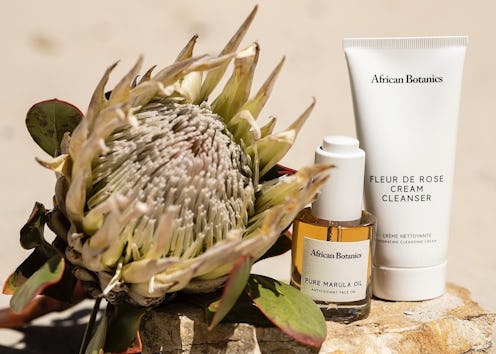(Beauty)
Dry, Dehydrated Skin? Try This ASAP

My fascination with natural skincare ingredients knows no bounds. Of course, this is just my personal opinion, but I feel like the power that’s inherently present in every single microscopic plant cell is so much cooler than anything a human could create in a lab. Take, for example, desert plants — aka, the hydrating skincare ingredients your dry skin is begging for. Plants like aloe vera, cactus, and prickly pear were made to thrive in dry climates and thus, to hoard hydration. When applied to the skin, those same water-binding properties are passed onto you. I mean, that’s mind-blowing stuff, right?
“I am similarly fascinated by each of these ingredients,” Dr. Devika Icecreamwala, a board certified dermatologist based in San Francisco, tells The Zoe Report. She says the nature of the aforementioned plants — along with other desert-dwellers like Kalahari melon, African resurrection plant, and yucca extract — potentially makes them more likely to provide dehydrated skin with much-needed moisture. So if your face is feeling a little parched, a skincare product infused with desert flora might be just want the dermatologist ordered.
“Desert plants have adapted to cope in harsh conditions, including extreme pressure, heat, cold, dryness, and radiation,” Julia Noik, the founder of African Botanics, a skincare brand that relies on ingredients from the deserts of Africa, tells TZR. As such, they contain enzymes that allow them to survive in extreme climates, as well as high levels of antioxidants to protect from sun damage and free radicals. “The levels of antioxidants found in these plants have exceeded the traditional activity found in standard plants grown in milder climates,” Noik says. “This is what makes desert plant extracts so unique and effective in our skincare formulations.”
Dr. Icecreamwala is particularly drawn to products featuring aloe vera and cactus extract for dry or irritated skin. “I love aloe vera — it is very soothing and works really well when your skin is irritated or inflamed,” she says. “I recommend patients use it after they get a sunburn.” While the ingredient is definitely most well-known for its ability to calm sun-damaged skin, it has so much more to offer. With a high concentration of water and a dose of mucopolysaccharides, aloe also binds moisture to the skin and even helps stimulate production of collagen and elastin. The effect? Less inflammation, fewer fine lines, and an overall glow.
Plants in the cacti family similarly help the skin store water. “Cactus extract is a great ingredient because it’s comprised of essential fatty acids,” the derm adds. “These help provide moisture in addition to vitamins E and K.” Those properties make cactus extracts particularly beneficial in micellar waters or face mists, like Pacifica Cactus Water Micellar Cleansing Tonic and Kiehl’s Cactus Flower and Tibetan Ginseng Hydrating Mist.
Prickly pear is one particular species of cacti that has been making skincare enthusiasts’ ears, uh, prick up with interest lately, and for good reason. One scientific study showed that prickly pear extract increases skin’s natural levels of hyaluronic acid (meaning, more moisture), decreases TEWL (that’s TransEpidermal Water Loss — meaning, again, more moisture), and even protects from UV rays. Prickly pear seed oil also features high levels of linoleic acid, making it ideal for treating acne. “Linoleic acid is a fatty acid that is [naturally] produced at lower than normal levels in the skin of patients who have acne,” Dr. Joshua Zeichner of Zeichner Dermatology in New York City tells TZR. “By using it, it can help restore an abnormal and inflamed skin barrier in acne patients.”
The same can be said of Kalahari melon seed oil, which is also high in linoleic acid and can be found in African Botanics Fleurs D’Afrique Intensive Recovery Oil. “Kalahari melons grow in harsh desert conditions, so their seeds are rich in antioxidants and phytonutrients, too,” Noik says. “The oil is deeply hydrating and anti-inflammatory, and is suitable for all skin types including oily and acne-prone skin.”
The star of African Botanics’ line, though, is the African resurrection plant — I could nerd out on this one all day. “The Resurrection plant, or Myrothamnus flabellifolius, is indigenous to South Africa, where it grows on rocky soil where most plants can’t survive,” Noik explains. “This plant can tolerate up to 95 percent water loss for months, even years, but revive completely after 24 to 48 hours of exposure to water.” It gets better: Resurrection plants stay alive by “switching on” specific genes during periods of drought — essentially, they secrete sugars to protect their tissue until more water comes along. “In this way, resurrection plants are not only drought-resistant, they are also highly sugar nutritious,” Noik says.
What does that mean for your skin? A couple things: One, thanks to that sugar, African resurrection plant extract has antioxidant properties to protect the skin from environmental damage. And two, it “helps protect skin fibroblasts from dehydration by replacing water and acting as a natural cellular moisturizer,” Noik says.
Although studies on the ingredients aren’t extensive, it seems these desert-plucked plants don’t have many side effects at all, per Dr. Icecreamwala. They’re generally safe for use against all skin types — especially those who are dry, dehydrated, or acne-prone. “As we continue to incorporate more of these into skincare over time, we will better understand the broader effects,” the dermatologist says.
Ahead, 21 products that pull their power from Mother Nature’s ultimate hydrators.
Shop Cactus Extract
Shop Prickly Pear Seed Oil
Shop Kalahari Melon Seed Oil
Shop African Resurrection Plant
Shop Aloe Vera
This article was originally published on